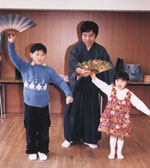He puts on a pair of white tabi--special socks with a split big toe--and readies his dancing fan. He sits on the floor, his legs tucked underneath, and bows deeply to Mr. Inoue before his lesson. His face suddenly grows serious, and his attention is focused; just a minute ago, though, he was chattering and running around the room.
 Susumu and Aya practice. |
His teacher begins to sing. Susumu moves quickly in rhythm to the voice, using a special walking technique called suriashi--gliding across the floor. This is a basic technique that everyone learns when studying noh dancing. The dance Susumu is practicing requires him to jump up and twist in the air full circle before landing in a kneeling position. It's almost as if he's figure skating. This is a move called tobikaeri, one of around just 40 with which all noh plays are performed. Susumu says with a gleam in his eyes that his favorite pieces are the ones with a lot of movement.
The first thing that Mr. Inoue has children learn is the basic order of steps. Then he corrects their posture. "The important thing is to make noh fun so that kids will want to practice. It's not a good idea trying to cram too many things into young children; you want them to be full of energy, even if they aren't doing everything right."
